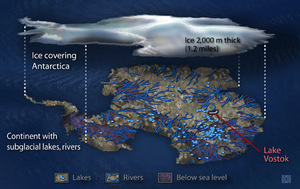Antarctica is not a barren polar desert but a rich, complex environment that may contain a thriving "oasis of life," experts say.

|
| ©Zina Deretsky/NSF
|
| If scientists peeled back the Antarctic ice sheet, a complex system of complex rivers of lakes similar to Earth's surface would emerge. To date little is known about this inaccessible environment, although preliminary research suggests subglacial bodies of water may harbor some basic life-forms.
|
Researchers have uncovered a complex subglacial system miles under the ice where rivers larger than the Amazon link a series of "lake districts," which may teem with mineral-hungry microbes.
This watery environment may be more than one-and-a-half times the size of the United States, scientists say, which would make it the world's largest wetland.
"This is essentially a whole new world that ten years ago we didn't know existed," said Michael Studinger, a geophysicist at the Lamont-Doherty Earth Observatory of Columbia University in New York.
"If you peel back the ice sheet, you would expect a watery landscape similar to what we would see on the surface of Earth."
Dramatic DevelopmentStudinger's research focuses on "recovery lakes," part of a a
series of cascading lakes found earlier this year under the ice sheet.
The lakes - isolated from the atmosphere for more than 30 million years - ebb and flow as they empty into the polar sea. They stay fluid because the ice sheet above acts like a gigantic down blanket, trapping heat rising from Earth's interior.
About
145 lakes have been found, under ice up to 2.5 miles (4 kilometers) thick.
Recovery lakes trigger ice streams that lubricate and drain parts of the ice sheet into the ocean, meaning they may provide surprising insights into the effects of global warming, Studinger said.
Because so much of Earth's freshwater is tied up in these ice sheets, warming trends may add to the lubricating effect and release more water than anticipated into the ocean, raising sea levels.
"Fifteen years ago people thought the east Antarctic ice sheet was frozen to bedrock, but now we know that's not the case," he said.
"This is a dramatic development in the way we look at Antarctica."
In 2008 Studinger plans to fly over Antarctica in an airplane equipped with new radar technology that can "see through" ice and detect new lakes.
"It's difficult to say how many more lakes, but what we know for sure is we will discover more," he said.
Only a very small portion of Antarctica's land mass has been surveyed, mostly because it is one of the most inaccessible places on Earth, Studinger added.
Untapped Resources
Mahlon C. Kennicutt II, a professor of oceanography at Texas A&M University, leads several Antarctic research groups.
Scientists who thought such underground lakes were mere anomalies in the late 1990s now realize the bodies of water are fundamental to several Earth processes, Kennicutt said.
"Our whole agenda has broadened," he said.
Outbursts from subglacial lakes, for example, may have a lot to do with how the continents are shaped and reshaped.
The lakes may also hold an untapped wealth of climate records that could improve our understanding of how life evolved, he added.
Some of these mysteries might be cracked within months, when Russian scientists drill down 2.3 miles (3.8 kilometers) to reach Lake Vostok. The giant lake, 2.5 miles (4 kilometers) beneath eastern Antarctica, was found in 1996 using satellite imagery and specialized radar technology.
If successful, the team will become the first to sample water from the lake.
"Pretty Big House"Lakes are one thing - but not long ago, few suspected that life could survive in such extreme conditions.
John Priscu, an ecologist at Montana State University in Bozeman, for example, began studying organisms that live in frozen ice in 1992.
"That was a really big start - other scientists started jumping around and saying, Wow, we can have biology in solid ice," Priscu said.
Later Priscu began working on ice from Lake Vostok, and found evidence that
microbes can live in the subglacial lake, deriving energy from minerals - as he put it, "eating rocks."
Priscu and his postdoctoral student, Brent Christner, took some lake water that was refrozen at the bottom of the ice sheet above Lake Vostok and compared DNA found in the ice with DNA of organisms listed in gene banks.
Several of the DNA sequences from the gene bank were similar to the DNA in the ice - suggesting comparable organisms live in the subglacial lake.
The microbes may survive in little veins wedged between frozen crystals of ice - "a pretty big house for microorganisms," Priscu said.
Could more advanced life-forms lurk under the ice sheet? "I'm not sure there is enough energy down there ... to make a Loch Ness monster," Priscu said.
But if hydrothermal vents are found in Lake Vostok that resemble energy-rich, biodiverse vents in the deep ocean, higher-order organisms could be possible, he added.
"To be honest I would be surprised if there's no microbial life in the lake," Studinger of Columbia University said.
"Pretty much wherever we have found water on this planet we find at least some sort of microbial life."
Life on Mars?Antarctica's frigid remoteness has at least one benefit to science: it is a polar desert with similarities to Mars and the Jovian moon Europa, Priscu added.
These comparisons may help scientists who are studying the "emerging picture of life" on other icy worlds, he said.
For example, based on their study of Antarctica microbes, Priscu and colleagues have published research in the
Journal of Astrobiology describing how life might exist in Mars's frozen ground.
"Slowly but surely, people are starting to realize this is a new frontier," he said.
"Antarctica has a lot of secrets that haven't been unlocked yet."
Reader Comments
to our Newsletter